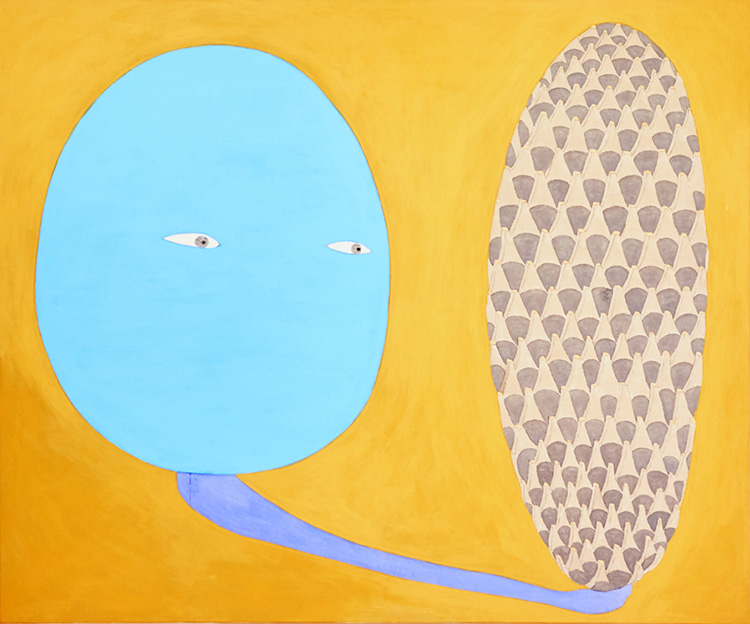綿引展子 WATABIKI Nobuko

上 −《家族の肖像C+K》2019年 キャンバスに布(古着)
Familienportrait, C (Germany) + K (Japan), 2019, Cloth on canvas
180×150cm
下 − 石のインスタレーション 2018年 自然石に糸
Stone Installation, 2018, Stone, Thread
綿引展子個展「家族の肖像」、クンストラーハウス
ハンブルク−ベルゲドルフ、ドイツ 2019年
Familienportrait, Künstlerhaus Hamburg – Bergedorf, Germany, 2019
綿引展子
WATABIKI Nobuko
1958年東京生まれ、ハンブルク(ドイツ)在住・活動。
1980年代から自分の幼少期の写真をモティーフにしたボックス・アートを発表してきた綿引は、1994年頃から和紙にオイル・パステルを使った絵画に転じた。彼女が描くのはつねに自分の分身でもある不器用な人物が、社会や他者とかかわる上での齟齬や軋みであり、疎外された人物の孤独や怒りであった。2008年に拠点をハンブルクに移してからは、ドイツの古着やシーツを素材としたパッチワーク風の布の作品も多く制作するようになるが、その表現内容は変わってはいない。布を使うようになったきっかけは、ドイツの布を使うことでドイツ的な色彩を扱いたいと思ったことだそうだが、ドイツ人には綿引の作品は日本的に見えると言われるらしい。
綿引の持ち味は独特の不気味さを交えたユーモアと粘り強さにあり、けっして孤独や疎外にひきこもらずに、外に向ってシグナルを発し続けて行くに違いない。
小勝禮子 綿引展子・作品解説「アジアをつなぐ―境界を生きる女たち1984-2012」展図録(福岡アジア美術館ほか、2012年)より一部抜粋。
今展ではその同じ手法で、異なる国籍のカップルから二人の古着を提供してもらい、それを組み合わせて《家族の肖像》というシリーズを制作している。自身もドイツ社会の中の移民という立場から、今、世界的に問題となる移民や難民の流入をテーマとして、異なる個性や文化を残しながら共生するカップルの様々な「肖像」として巨大な布のパッチワークを制作した。2人の衣服が違和感なく溶け合うカップルもいれば、それぞれの個性を主張して激しくぶつかる布もある。人間が作る社会の多様なあり様の可能性が見事に視覚化されているのだ。
小勝禮子「彼女たちの叫びとささやき―ヴァルネラブルな集合体は世界を変えたか?」、『彼女たちは叫ぶ、ささやく―ヴァルネラブルな集合体が世界を変える』展カタログ、エゴイメ・コレクティヴ、2020年より一部抜粋。
Born in Tokyo, Japan, 1958. Lives and works in Hamburg, Germany.
Having made presentations of box art with pictures from her childhood as a motif since the 1980s, Watabiki Nobuko moved on to paintings on Japanese washi paper using oil pastels. What she paints is always people who are awkward, just as a part of her is, and who experience discord and strife in their interactions with others and society. She also paints the loneliness and anger of those who have been outcast. In 2008, she relocated to Hamburg, and has since also made old clothes and bed sheets into materials for patchwork-like cloth works. While she produces these, the content remains the same as her paper-based works. What led her to use cloth was apparently her desire to achieve a German color scheme via German cloth. However, Germans often comment that her works look Japanese to them.
It’s really that Watabiki’s inherent characteristic lies in the way she has changed the eerie into something humorous that sticks with the viewer. There is no doubt that she will continue to send her signal to the world, and without ever succumbing to loneliness or rejection.
-Excerpt from the comment about Watabiki Nobuko in Women In-Between: Asian Women Artists 1984-2012 (Exh.Cat.), Fukuoka Asian Art Museum, 2012 (Kokatsu Reiko / Translated by Sam Innes)
She adopted that same method for the works in this exhibition, except she had several couples of different nationalities supply their old clothes. She combined the clothes of each couple and created the series Family Portrait. The theme was the current worldwide problems involving the influx of immigrants and refugees, which she saw from the point of view that she herself is an immigrant in German society. Based on this theme, she created huge cloth patchworks, seen as the various “portraits” of the different couples who respectively lived together, while also maintaining their own individualities and cultures. In some works, the clothes of one couple merged together without any discord, while in others, the cloths of a different couple clashed, due to the two conflicting characteristics. Watabiki exquisitely visualized the possibilities inherent in the diverse state of society that is created by human beings.
-Excerpt from Kokatsu Reiko, “The Shouts and Murmurs of Women-Did the Vulnerable Collective Change the World ?”, The Shouts and Murmurs of Women-the Vulnerable Collective Will Change the World (Exh.Cat.), egó eímai collective, 2020 (Translated by Nanpei Taeko)
更新された最新の情報は、作家のウェブサイト、SNS等をご覧ください。
Please refer to the artist’s website/social media pages for new updates.
https://www.instagram.com/nobukowatabiki/
https://www.facebook.com/nobuko.watabiki

《楽園-心》 2020年 キャンバス、アクリル
Paradies – Herz, (Paradise – Heart), 2020, Acrylic on canvas
150×180cm

《家族の肖像M+S》 2020年 キャンバスに布(古着)
Familienportrait, M (Japan) + S (Switzerland), 2020, Cloth on canvas
180×150cm

《無題》 2019年 和紙にオイルパステル
Untitled, 2019, Oil pastel on japanese paper
100×70cm

